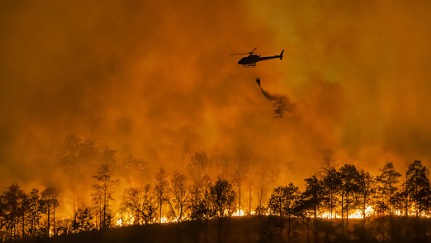Wildfire defense guide

Let’s start with reasons why your home is more at risk.
- According to CoreLogic®, more than 2.5 million U.S. homes are at extreme risk for wildfires.1
- According to the 2022 Annual Report of Wildfires produced by the National Interagency Fire Center (NIFC), 68,988 wildfires were reported and 7.5 million acres were burned in the U.S. in 2022.2
Environmental factors are driving the increase in risk.
- Temperatures are rising - The 12 months from Nov. 1, 2022, to Oct. 31, 2023, were Earth’s hottest on record.2
- Forests are drier, longer - About 37 percent of the continental U.S. remains under some form of drought, according to the U.S. Drought Monitor.2
Plan now to help protect your property from future wildfires. First, make your home as fire-resistant as possible with these important measures.
- Use fire-resistant roofing materials to cover your home, such as concrete tile or Class A composition shingles.
- If your home has a barrel tile roof, seal open edges with grout to keep embers from blowing into your home.
- Cover your attic, eave, and sub-floor exterior vents with 1/8” or smaller mesh screening made of a fire-resistant material, such as stainless steel.
- Box in or enclose eaves soffits for better protection from a fire’s heat and embers.
- Install multi-pane and/or tempered glass in exterior windows, glass doors and skylights.
- Use fire-resistant materials for siding, shutters, decks and fences.
- Keep gutters clean and install gutter guards to keep debris out.
Next, make landscaping fire-resistant to create a defense zone around your home.
- Avoid landscaping with combustible wood mulch.
- Plant native, fire-resistant vegetation whenever possible.
- Keep grass cut short and the 30’ area around your home watered well.
- Clear vegetation, including dry grass, brush, trees and dead leaves, within at least 100 feet of your home and other structures on your property.
- Store firewood and fuel sources at least 30 feet downhill from any structure.
What to do if a wildfire threatens your home
Natural disasters such as wildfires are scary, but having a plan in place can give you peace of mind and a sense of control. A plan can also help reassure children if you have them.
Take care of yourself and your family first.
- Monitor news reports so you know how much danger you may be facing.
- Review the contents of your emergency kit. Here’s a good list of kit basics.
- Change batteries in flashlights and have extra batteries on hand.
- Check your first-aid kit and prescription medicines.
- Stockpile candles and matches.
- Get cash to fill up your gas tank in case the pump credit card readers are down.
- Make sure your vehicles have chargers for your electronic devices.
- Don’t forget supplies for your pets!
If there’s time and it’s safe to do so, do what you can to protect your home.
- Quickly remove any dry brush in your yard that could easily catch fire.
- Soak any roofs, shrubs and trees with water if they are within 15 feet of a building.
- Remove flammable materials such as trash, portable propane tanks, outdoor furniture and vehicles from around your home.
- Shut off the gas to the home to prevent an ignition source.
- Make sure vents are covered securely with mesh to prevent embers from entering.
- Turn on your roof sprinkler system, if you have one, and any sprinklers on your property.
- Move all vehicles into the garage, close and lock all doors and windows, and activate your security system.3
- Do a full video walk-through of your home and property before you evacuate. Take photos of the serial numbers on your electronics, if possible. The footage will provide your insurance company with a detailed record of the state of your property right before disaster hit.
- Evacuate art, antiques and other valuables.
What to do if you’re forced to leave your home.
- Leave garden hoses connected and accessible to make it easier for firefighters to fill their tanks.
- Know and follow routes dictated by local officials. Wildfires can quickly change direction and your planned escape route may be blocked.
- Post a sign on your home with your name and contact number in case first responders need to reach you.
What to do after a wildfire.
- If you evacuated, do not return home until local officials deem it safe to do so.
- Check your roof, attic and home perimeter for small fires or burning embers and extinguish them immediately. Call the fire department for help if you need help.
- Inspect all utilities and if any damage has occurred, consult a professional before using them.
- If you notice any damage to your home, contact your insurance agent.
1 Facts + Statistics: Wildfires,” Insurance Information Institute, https://www.iii.org/fact-statistic/facts-statistics-wildfires (accessed March 25,2024).
2“Wildfires: State of the Risk” Insurance Information Institute, https://www.iii.org/sites/default/files/docs/pdf/triple-i_state_of_the_risk_wildfire_11272023.pdf
3“How to Prepare for a Wildfire,” fema.gov (updated March 16, 2021). Wildfire Defense Systems’ services not available in all states. Condominium and renters policies are not eligible. Nationwide and WDS make no guarantee WDS’ services will prevent damage.